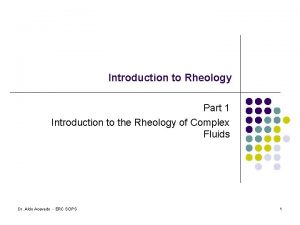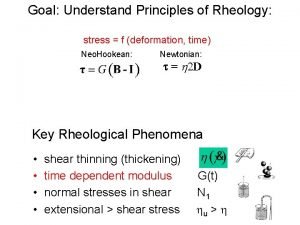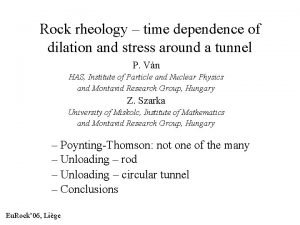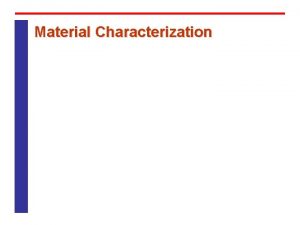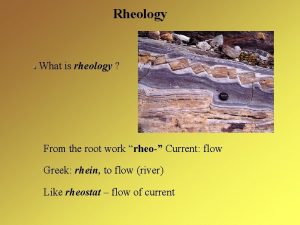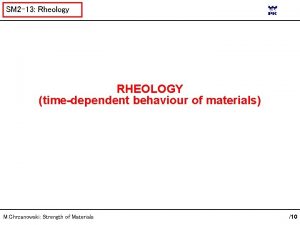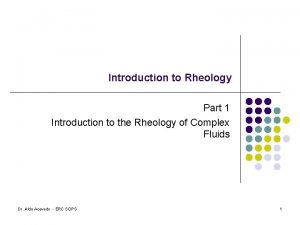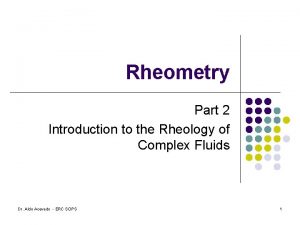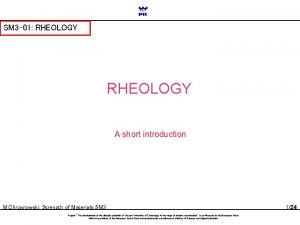CHAPTER 5 RHEOLOGY Introduction Rheology is the study

















































- Slides: 49

CHAPTER 5 RHEOLOGY

Introduction • Rheology is the study of the flow of material. • In Other words: The relation between stress and strain with time. • Do rocks flow? • Geologically speaking and due to the availability of time, rocks are able to flow. Not in the same physical meaning, but with the final result, which can be achieved by rocks.

Strain Rate Strain rate (ė) is the time interval it takes to accumulate a certain amount of strain; and it is defined as the elongation per time. • ė = e/t = l/l 0 t t in second Example: 30% finite longitudinal strain (|e|= 0. 3) is achieved in an experiment that lasts one hour (3600 s). The correspond strain rate is ė = 0. 3/3600 = 8. 3 x 10– 5/s Now let’s see what happens to the strain rate when we change the time interval, but maintain the same amount of finite strain of 30%. t=1 day (86. 4 x 103 s) ė =3. 5 x 10– 6/s t=1 year (3. 15 x 107 s) ė =9. 5 x 10– 9/s t=1 m. y. (3. 15 x 1013 s) ė =9. 5 x 10– 15/s

Q: What is the strain rate of a 200 km long thrust sheet moving 50 km in 1 m. y. ? Answer: Now we can calculate the strain rate ė = e/t = l/l 0 t = 50/(200 x 3. 15 x 1013 ) ė = 0. 8 x 10 -14/s In some cases, shear strain rate preferred to be used rather than strain rate. The relation between shear strain rate (γ ) and strain rate is: γ = 2 ė

• A widely used estimate is based on the Quaternary displacement along the San Andreas Fault in California, which gives a strain rate on the order of 10– 14/s (moderate geological strain). • Which agrees well with present-day observation of plate velocities. • For geological processes, the typical range of strain rate is between 10 -12/s to 10 -15/s. There are some exceptions.

General behavior: the creep curve • Three creep regimes are obtained: I. Primary or transient creep (decreasing strain rate) II. Secondary or steady-state creep (constant strain rate) III. Tertiary or accelerated creep (increase strain rate)

Rheologic Relationships • The behavior of materials can be divided into three types: 1. Elastic behavior: recoverable and instaneous response to stress (time independent) 2. Viscous behavior (Plastic behavior in rock) 3. Combination of elastic and viscous behaviors (visco-elastic and elastico-viscous)

The stress-strain relation is commonly expressed in graphs known as stress-strain diagrams. 1. Curve A is a brittle substance. 2. Curve B is an ideal plastic substance. 3. Curve C more normal type of plastic behavior 4. Curve D another common type of plastic deformation.

• Stress-strain curve showing three types of rheological behavior: 1. Elastic region: Stress is proportional to strain (Hook’s law) 2. Plastic region: Behave according to ductile flow. 3. Brittle Failure region : fracture. * Elastic limit is the maximum stress under which the material exhibits elastic strain. Beyond this value, the material undergoes permanent deformation by ductile flow or by brittle fracture.

MODULE OF ELASTICITY

Modulus of Elasticity or Young’s Modulus • We can express elastic behavior by the equation: § σ = E • e, § where E is the modulus of elasticity or Young’s Modulus

Dimensions of Young’s Modulus • Since strain I dimensionless, Young’s modulus has the same units as stress, Pascals • A typical value of Young’s modulus for rocks is -1011 Pa • The sign is negative because we apply a positive stress (compression) to produce a negative elongation (shortening)

Shear Modulus or Rigidity • Another expression for elastic behavior is given by § σs = G • γ § where G is the rigidity and γ is shear strain

Bulk Modulus or Compressibility • We can also write equations for dilation: § σ = K • ((V - V 0)/V 0) § K is the bulk modulus, or incompressibility § Its reciprocal is the compressibility, β

Poisson’s Ratio • This ratio may be expressed as: § ν = e ┴ /e // § where e┴ is the elongation perpendicular to the compressive stress § e// is the elongation parallel to compressive stress

Stress Removal • After stress is removed, there is a rapid drop in strain, followed by a period of relaxation, during which the strain decreases a bit more before

Viscous Behavior Diagram • The symbol to the left is a “dashpot”, a type of leaky piston-cylinder apparatus • Resistance encountered by the piston depends on the viscosity of the fluid

Definition of Viscosity • Viscosity is defined by the term η in the equation relating stress and strain rate: § σ=ηė • Viscosity dimensions may be deduced from the equation.

Low Viscosity Position after short period of flow Initial position

Moderate Viscosity • Videos of pahoehoe flows, Hawaii

Relative Viscosities Substance Air (at 18 o. C) Water (at 20 o. C) Canola Oil at room temp. Motor Oil at room temp. Corn syrup at room temp. Pahoehoe lava A'a lava Andesite lava Rhyolite lava Viscosity (Pa s) 1. 9 x 10 -5 (0. 000019) 1 x 10 -3 (0. 001) 0. 1 1 8 100 to 1, 000 1000 to 10, 000 106 to 107 1011 to 1012

Visco-elastic Equation • The equation for visco-elastic behavior is: § σ=E • e+ηė • An example is a sponge filled with water

Strength versus Depth

Natural Rocks • It is very important to examine the relationships between stress, strain and strain rate by using natural rocks to have better understanding of the flow of rock (Rheology). • What are the main reasons of doing experiments on natural rocks? 1. We observe the actual behavior of natural rocks. 2. We can vary several parameters in our experiments such as pressure, temperature, time and fluid pressure, and to examine their role in rock deformation.

The effect of the following parameters in the triaxial tests are:

Effective Pressure • pc - pf is equal to the effective pressure • Pistons at both ends of the cylinder allow the experimenter to impose pressure along the vertical axis, called the axial stress

1. Confining (Lithostatic) Pressure (Pc) Acts equally in all direction ( 1 = 2 = 3) By changing the confining pressure during the experiments, we observe a very important characteristic. 1. With increasing confining pressure greater amounts of strain accumulate before failure occurs. 2. Increasing confining pressure, increases the viscous component and the rock’s ability to flow. 3. Higher confining pressures increasingly resist the opening of fractures. • •

Clapping Underwater • Clapping one’s hand in the air is easy, but doing it under water is much harder • The water resists movement


• By increasing the experimental temperatures the effects of confining pressure become clear. 4. Larger strain can be achieved before failure with increasing depths in the Earth (lithostatic).

• The amount of strain before failure (ductility) differs significantly among the various rock types

2. Temperature • A change in temperature conditions also produces a marked change in response. 1. The block fails readily at low T. 2. At these conditions most of the strain prior to failure is recoverable (elastic). 3. When T increases, the elastic portion of the strain decreases while the ductility (viscosity) increases. 4. Rocks have lower strength and become more ductile with depth in the Earth, where we find higher T.


Differential Stress vs. Temperature • Effect of increasing temperature on the ability of various rocks to withstand a given differential stress • In all cases, the rocks grow weaker as temperature increases, but the effect is much higher on pure calcite than other materials.

3. Strain Rate 1. Decreasing the strain rate results in decreased rock strength and increased ductility (viscosity) 2. T. changes produce similar effects as strain rate variations in rocks experiments (h. T s. ė)

Young Experimentalist • Human factors also play a role • Old experimenters may die or become incapacitated • Younger experimenters, who face lower odds of either event happening, have to obtain results quickly to justify continued funding

4. Pore-fluid Pressure • Some rock types (sandstone, shale) contain a significant fluid component that affects their behavior under stress. • Experiments show that increasing the pore-fluid pressure produces a drop in the strength and reduces the ductility of the sample.

Quartz, Wet and Dry • Effect of water on the mineral quartz • Strength decreases as temperature increases, while the quartz is dry, but plummets when it is wet.

• Rocks are weaker when the pore-fluid pressure is high. • Increasing the pore-fluid pressure will have the same effect as decreasing the confining pressure of the experiment. Effect pressure = Confining pressure – fluid pressure (Pe = Pc – Pf)

Significance of Experiments to Natural Conditions • Increasing the confining pressure (Pc) and fluid pressure (Pf) have an opposite effects. • Increasing temperature (T) and lowering strain rate (ė) have the same effects. • Confining pressure and temperature, which both increase with depth in the Earth, result in rocks that increasingly resist failure, while at the same time they allow larger strain accumulation, and increase the ability for rocks to flow. • High fluid content is more complex and may promote fracturing if Pf is high.


Strain Softening and Hardening • Curve D no elastic component, with strain softening • Curve E is elastic-plastic behavior, with permanent strain at constant stress above the yield stress. • Curve F is elastic strain followed by permanent strain that requires increasingly higher stresses to accumulate (strain hardening)

Terminology • We also need to introduce some other terms – Strength is the stress a rock can withstand without failure – Competency compares the resistance of various rock to flow • Qualitative competency guides have been developed from field observations and from experimental data

Competency Guides, Sedimentary Rocks • In increasing order of competency: § § § Salt (Low) Shale Limestone Graywacke Sandstone Dolomite (High)

Competency Guides, Crystalline Rocks • In increasing order of competency: § § § Schist (Low) Marble Quartzite Gneiss Granite Basalt (High)

Rheological Properties of Minerals • Experimental data can also be used to categorize rheological properties on the basis of properties of the major minerals which comprise the rocks.

• From the previous observation we would predict that: 1. Brittle behavior (fracturing) is largely restricted to the upper crust. (faulting and earthquakes < 15 km depth). 2. Ductile behavior (flow) dominates at greater depth.

• One of the geological structure’s classification based on the cohesiveness during deformation: Brittle Fracture system Ductile Fold system Brittle-ductile Shear zones

Brittle-Ductile Classification Scheme • • (a) brittle (Faults) (b) brittle-ductile (faults and folds) (c ) brittle-ductile (small crack faulting and folding) (d) ductile (folding)
 Shear thinning
Shear thinning An introduction to rheology
An introduction to rheology An introduction to rheology
An introduction to rheology Scale of flowability
Scale of flowability Rheology exam questions
Rheology exam questions Rheology in pharmacy
Rheology in pharmacy Rheology in pharmacy
Rheology in pharmacy Rheology
Rheology Dilatant flow is reverse phenomenon of
Dilatant flow is reverse phenomenon of Blood rheology definition
Blood rheology definition Rheology lab
Rheology lab Prorubriblast
Prorubriblast Rock rheology
Rock rheology Aulton
Aulton Hát kết hợp bộ gõ cơ thể
Hát kết hợp bộ gõ cơ thể Slidetodoc
Slidetodoc Bổ thể
Bổ thể Tỉ lệ cơ thể trẻ em
Tỉ lệ cơ thể trẻ em Chó sói
Chó sói Tư thế worm breton
Tư thế worm breton Chúa yêu trần thế alleluia
Chúa yêu trần thế alleluia Môn thể thao bắt đầu bằng chữ đua
Môn thể thao bắt đầu bằng chữ đua Thế nào là hệ số cao nhất
Thế nào là hệ số cao nhất Các châu lục và đại dương trên thế giới
Các châu lục và đại dương trên thế giới Công thức tiính động năng
Công thức tiính động năng Trời xanh đây là của chúng ta thể thơ
Trời xanh đây là của chúng ta thể thơ Mật thư anh em như thể tay chân
Mật thư anh em như thể tay chân Phép trừ bù
Phép trừ bù Phản ứng thế ankan
Phản ứng thế ankan Các châu lục và đại dương trên thế giới
Các châu lục và đại dương trên thế giới Thể thơ truyền thống
Thể thơ truyền thống Quá trình desamine hóa có thể tạo ra
Quá trình desamine hóa có thể tạo ra Một số thể thơ truyền thống
Một số thể thơ truyền thống Cái miệng nó xinh thế chỉ nói điều hay thôi
Cái miệng nó xinh thế chỉ nói điều hay thôi Vẽ hình chiếu vuông góc của vật thể sau
Vẽ hình chiếu vuông góc của vật thể sau Nguyên nhân của sự mỏi cơ sinh 8
Nguyên nhân của sự mỏi cơ sinh 8 đặc điểm cơ thể của người tối cổ
đặc điểm cơ thể của người tối cổ Thứ tự các dấu thăng giáng ở hóa biểu
Thứ tự các dấu thăng giáng ở hóa biểu Vẽ hình chiếu đứng bằng cạnh của vật thể
Vẽ hình chiếu đứng bằng cạnh của vật thể Fecboak
Fecboak Thẻ vin
Thẻ vin đại từ thay thế
đại từ thay thế điện thế nghỉ
điện thế nghỉ Tư thế ngồi viết
Tư thế ngồi viết Diễn thế sinh thái là
Diễn thế sinh thái là Dot
Dot Bảng số nguyên tố
Bảng số nguyên tố Tư thế ngồi viết
Tư thế ngồi viết Lời thề hippocrates
Lời thề hippocrates Thiếu nhi thế giới liên hoan
Thiếu nhi thế giới liên hoan
